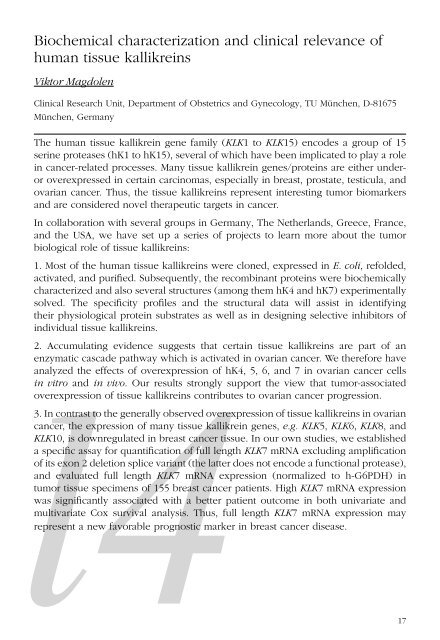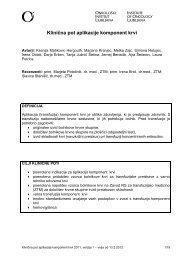Create successful ePaper yourself
Turn your PDF publications into a flip-book with our unique Google optimized e-Paper software.
Biochemical characterization and clinical relevance of<br />
human tissue kallikreins<br />
Viktor Magdolen<br />
Clinical Research Unit, Department of Obstetrics and Gynecology, TU München, D-81675<br />
München, Germany<br />
The human tissue kallikrein gene family (KLK1 to KLK15) encodes a group of 15<br />
serine proteases (hK1 to hK15), several of which have been implicated to play a role<br />
in cancer-related processes. Many tissue kallikrein genes/proteins are either underor<br />
overexpressed in certain carcinomas, especially in breast, prostate, testicula, and<br />
ovarian cancer. Thus, the tissue kallikreins represent interesting tumor biomarkers<br />
and are considered novel therapeutic targets in cancer.<br />
In collaboration with several groups in Germany, The Netherlands, Greece, France,<br />
and the USA, we have set up a series of projects to learn more about the tumor<br />
biological role of tissue kallikreins:<br />
1. Most of the human tissue kallikreins were cloned, expressed in E. coli, refolded,<br />
activated, and purified. Subsequently, the recombinant proteins were biochemically<br />
characterized and also several structures (among them hK4 and hK7) experimentally<br />
solved. The specificity profiles and the structural data will assist in identifying<br />
their physiological protein substrates as well as in designing selective inhibitors of<br />
individual tissue kallikreins.<br />
2. Accumulating evidence suggests that certain tissue kallikreins are part of an<br />
enzymatic cascade pathway which is activated in ovarian cancer. We therefore have<br />
analyzed the effects of overexpression of hK4, 5, 6, and 7 in ovarian cancer cells<br />
l4<br />
in vitro and in vivo. Our results strongly support the view that tumor-associated<br />
overexpression of tissue kallikreins contributes to ovarian cancer progression.<br />
3. In contrast to the generally observed overexpression of tissue kallikreins in ovarian<br />
cancer, the expression of many tissue kallikrein genes, e.g. KLK5, KLK6, KLK8, and<br />
KLK10, is downregulated in breast cancer tissue. In our own studies, we established<br />
a specific assay for quantification of full length KLK7 mRNA excluding amplification<br />
of its exon 2 deletion splice variant (the latter does not encode a functional protease),<br />
and evaluated full length KLK7 mRNA expression (normalized to h-G6PDH) in<br />
tumor tissue specimens of 155 breast cancer patients. High KLK7 mRNA expression<br />
was significantly associated with a better patient outcome in both univariate and<br />
multivariate Cox survival analysis. Thus, full length KLK7 mRNA expression may<br />
represent a new favorable prognostic marker in breast cancer disease.<br />
17

















